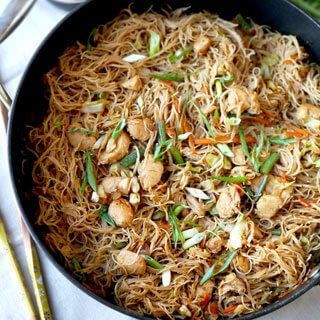Alternative names Pansit Variations Lutong pancit | ||
 | ||
Similar Lumpia, Sinigang, Sisig, Kare‑kare, Philippine adobo | ||
Pancit filipino noodle dish
In Filipino cuisine, pancit or pansit are noodles. Noodles were introduced into the Philippines by the Chinese and have since been adopted into local cuisine. The term pancit is derived from the Hokkien pian i sit (Chinese: 便ê食; Pe̍h-ōe-jī: piān-ê-si̍t or Chinese: 便食; pinyin: biàn shí) which literally means "convenient food." Different kinds of noodles can be found in Filipino supermarkets which can then be cooked at home. Noodle dishes are also standard fare in local restaurants. Food establishments specializing in noodles are often referred to as panciterias.
Contents
- Pancit filipino noodle dish
- Pancit bihon canton guisado recipe filipino noodle dish
- Variations
- Seaweed pancit
- References

Nancy Reyes Lumen of the Philippine Center for Investigative Journalism writes that according to food lore handed down from the Chinese, noodles should be eaten on one's birthday. They are therefore commonly served at birthday celebrations and Chinese restaurants in the Philippines often have "birthday noodles" listed on their menus. However, she warns that since "noodles represent long life and good health; they must not be cut short so as not to corrupt the symbolism."

Pancit bihon canton guisado recipe filipino noodle dish
Variations

Pancit bihon (aka bijon) is the type usually associated with the word "pancit", very thin rice noodles fried with soy sauce some citrus, possibly with patis, and some variation of sliced meat and chopped vegetables. The exact bihon composition depends on someone's personal recipe but usually, Chinese sausage and cabbage are the basic ingredients in a pancit bihon.
Pancit palabok and pancit luglug are essentially the same dish, the difference being primarily in the noodles used in the recipe. Luglug uses a thicker noodle than the traditional bihon of a pancit palabok. Both pancit dishes use a round rice noodle (often specifically labeled for pancit luglug or palabok) smothered with a thick, golden Shrimp sauce or other flavored sauce, and topped with:
Pancit palabok/pancit luglog and pancit canton are communal comfort food, and can be found at nearly all Filipino potluck parties. They are best made and eaten in batches for they are easily consumed.
Pancit sotanghon is a cellophane noodle soup with a chicken broth base. It may include some kind of meat and vegetable. A typical sotanghon is made with calamansi, sliced straw mushrooms, slivered dark-meat chicken and green onion.
Batil patong is not commonly known outside of Tuguegarao in the province of Cagayan in Northern Luzon, Philippines. It is an unusual noodle dish with a sauce based on soy and "cara-beef" beef broth. It is served with two piquant side dishes: a cup of egg-drop soup made with the same cara-beef broth; and a dish of chopped onions, vinegar or calamansi, chili peppers, and soy sauce. The noodles are usually wheat-based and are topped with ground cara-beef, pork liver, mung bean sprouts, and poached egg from whence the name batil patong literally "scrambled and placed on top" is thought to be derived. Sometimes, other vegetables, crushed pork-rind cracklings or chorizos are also added on top.
Pancit Lomi Originally from Batangas, Pancit Lomi is usually sold in eateries across the province. With the mobility of the Filipinos; however, other people got wind of pancit lomi and now you will see different lomihans (eateries with just lomi) whipping up their own pancit lomi, panciterias (eateries specializing in pancit) adding it in their menu, and carinderias (which are usually offering the usual viands and not pancit) starting to offer it alongside its other rice-based meals.
Seaweed pancit
Tiwi, Albay residents created a new pancit made from seaweed, which has health benefits. It is rich in calcium and magnesium and the seaweed noodles can be cooked into pancit canton, pancit luglug, spaghetti, or carbonara.
